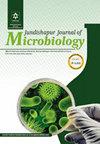从住院病人粪便中分离的粪肠球菌的遗传多样性、抗菌素耐药性和毒力因子
IF 0.5
4区 医学
Q4 MICROBIOLOGY
引用次数: 0
摘要
背景:粪肠球菌对不同的抗生素迅速产生耐药性,从而导致严重的医院感染,伴随着高死亡率和医疗保健系统的不同问题。目的:本研究旨在分析从伊朗中部一家医院患者粪便样本中分离的粪肠球菌的遗传多样性、耐药性和毒力因子。方法:在这项横断面描述性分析研究中,从2019年9月至2020年2月在伊朗中部一家医院住院的108名患者中收集了108份粪便样本。采用ddlE基因检测技术对分离的粪肠球菌进行检测,采用圆盘琼脂扩散法进行耐药性检测。采用聚合酶链反应(PCR)检测耐药基因和毒力因子。利用ERIC-PCR技术对肠杆菌基因间重复一致性进行遗传多样性分析。使用BioNumerics软件构建树突图。结果:108株分离物中检出粪肠杆菌50株,占46.2%;粪肠球菌多药耐药率为62%,多数菌株对四环素(70%)、红霉素(68%)和利福平(60%)耐药。其中,最常见的耐药基因为ermB(96%)、aph(2”)Ia(66%)、aac(6”)-Ie(40%)和ermC(30%);最常见的毒力基因为gelE(78%)、asa1(74%)和esp(74%)。遗传多样性分析显示,2个主要聚类(H和J)和8个次要聚类(A-G和I)共有25种ERIC类型,H和J聚类在耐药性和耐药基因方面差异无统计学意义(P < 0.05)。相反,asa1基因在J群中的流行率显著高于H群(P < 0.05)。结论:本研究显示,从住院患者粪便样本中分离出的粪肠球菌具有较高的多药耐药率,且异质性高。本文章由计算机程序翻译,如有差异,请以英文原文为准。
Genetic Diversity, Antimicrobial Resistance, and Virulence Factors of Enterococcus Faecalis Isolates Obtained from Stool Samples of Hospitalized Patients
Background: Enterococcus faecalis rapidly develops resistance to different antibiotics, thereby resulting in serious nosocomial infections associated with high mortality rates and different problems in the healthcare systems. Objectives: This study aimed to analyze the genetic diversity, antimicrobial resistance, and virulence factors of E. faecalis isolates obtained from the stool samples of patients in a hospital in the center of Iran. Methods: In this cross-sectional descriptive-analytical study, 108 stool samples were collected from September 2019 to February 2020 from 108 patients hospitalized in a hospital in the center of Iran. Enterococcus faecalis isolates were detected using the ddlE gene detection technique, and antimicrobial resistance testing was performed using the disc agar diffusion method. Moreover, polymerase chain reaction (PCR) was used to detect antimicrobial resistance genes and virulence factors. Genetic diversity was also analyzed by enterobacterial repetitive intergenic consensus using PCR (ERIC-PCR). The BioNumerics software was used to construct a dendrogram. Results: Of 108 isolates, 50 samples were E. faecalis (46.2%). The prevalence of multidrug resistance among E. faecalis isolates was 62%, and most isolates were resistant to antibiotics tetracycline (70%), erythromycin (68%), and rifampin (60%). Among the E. faecalis isolates, the most prevalent antimicrobial resistance genes were ermB (96%), aph (2′′) Ia (66%), aac(6′)-Ie (40%), and ermC (30%), and the most prevalent virulence genes were gelE (78%), asa1 (74%), and esp (74%). The genetic diversity analysis showed 25 ERIC types in two major clusters (ie, clusters H and J) and eight minor clusters (ie, clusters A-G and I). There was no significant difference between clusters H and J in terms of antimicrobial resistance and resistance genes (P > 0.05). In contrast, the prevalence of the asa1 gene was significantly higher in cluster J than in cluster H (P < 0.05). Conclusions: This study showed the high prevalence of multidrug resistance, and high heterogeneity among the E. faecalis isolates obtained from the stool samples of hospitalized patients.
求助全文
通过发布文献求助,成功后即可免费获取论文全文。
去求助
来源期刊

Jundishapur Journal of Microbiology
MICROBIOLOGY-
CiteScore
1.30
自引率
0.00%
发文量
56
审稿时长
6-12 weeks
期刊介绍:
Jundishapur Journal of Microbiology, (JJM) is the official scientific Monthly publication of Ahvaz Jundishapur University of Medical Sciences. JJM is dedicated to the publication of manuscripts on topics concerning all aspects of microbiology. The topics include medical, veterinary and environmental microbiology, molecular investigations and infectious diseases. Aspects of immunology and epidemiology of infectious diseases are also considered.
 求助内容:
求助内容: 应助结果提醒方式:
应助结果提醒方式:


